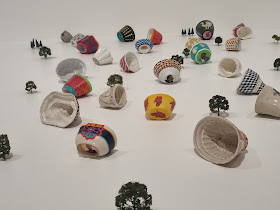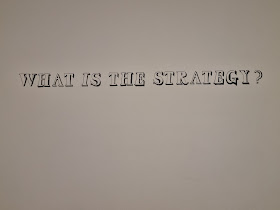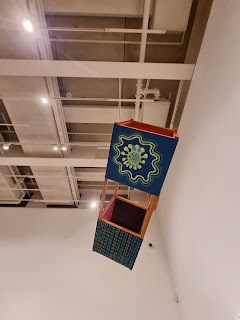"Our kisses are petals, our tongues caress the bloom" reads some lettering in acrylic painted directly on to the walls of Tate Modern as you enter their exhibition dedicated to the art of Lubaina Himid. It makes about as much sense as anything else you will see there - and that's not much at all. Or at least that's what my initial thoughts were. Then I decided to actually think a bit more.
Metal Handkerchiefs (2019)
Metal Handkerchiefs (2019)
Jelly Mould Pavilions for Liverpool (2010)
The only clues we have are a rather doggerelesque poem by Himid herself in the aforesaid pamphlet, a series of paintings of saws, pencils, and various other utensils adorned with slogans that seem to come from a health and safety manual, some 'jelly mould pavilions' (for Liverpool, apparently!), and a contention that Himid has played a "pivotal role in the British Black arts movement" from the 1980s onwards. Which included her winning the Turner Prize in 2017.
When I saw her work, as part of the Hayward Gallery's Mixing It Up exhibition last year, I observed that Himid's paintings, or at least the ones with people in them, are asking questions of us, the viewers. That they are presenting us with scenarios, often historical but sometimes modern, and asking us that if we were to inhabit these scenes which role we would take.
Power dynamics, basically. That's still true of much of Himid's figurative work but the abstract work? Well, it doesn't so much leave me cold as completely bewilder me in some cases. Somewhere between the two are the architectural caprices that border on graphic design (in the case of Country House) or seem to imagine a world in which we all live in homes designed by Frank Gehry or Antoni Gaudi (East Wing West Wing).
Country House (1997-98)
East Wing West Wing (1997-98)
She's trying to imagine what life would be like, how it would feel, if the built environment was tailored towards humanity's needs and desires rather than towards capital imperatives. This I can get on board with. In fact this is an interesting way to bridge gaps between conceptual, figurative, and abstract art. But it took me a bit of post-exhibition thinking to get round to realising that.
Damn artists. Making ME do the work. Blue Grid Test, another collaboration with audio artist Stawawska-Beaven, wasn't such an easy nut to crack. It was interesting to look at (hey, I like banjos, clocks, and newspaper obituaries) but what it meant I didn't know. A series of speakers from which, in various languages, several voices repeat words and phrases associated with the colour blue didn't really help me much either.
Lubaina Himid and Magda Stawarska-Beaven - Blue Grid Test (2020)
I wandered around the room slightly aimlessly and noted there were only a handful of other attendees at the exhibition. I wasn't surprised. This stuff is not an easy sell. The bright colours, and sense of abandonment - heck, one of the works is even called Abandoned - of Himid's series of deserted architectural spaces, however, should not deter the casual visitor.
There's something of Edward Hopper's solitariness or Ed Ruscha's neon lit gas stations about these works but also, in the colours used, a nod to the Fauvism of Andre Derain or Henri Matisse. As ever with Himid, though, there's more to these paintings than what we initially see. She's asking us to imagine what it would be like to live on the periphery of society, what it would be like to feel forgotten, what it would be like to not even know exactly where you are or where you're going?
Metal/Paper (Beach House) (1995)
Garfoni (1995)
Our Entire Food Supply (Plan B) (1999)
Window Box/Shutters (1998)
Abandoned (1998)
Often these images are presented as romantic, or even as ruin porn, and little thought is given to the people who inhabit these spaces in real life. What their actual lives are like. Himid's art disabuses us of that luxury yet, at the same time, are still lovely to look at. Some of them don't even have names and I couldn't help wondering if that's a reflection of how more privileged observers of poverty would rarely think to ask the names of the people who experience it.
Hierarchies seem to be of particular interest to Himid but it's not just racial, or social, ones she's focused on. She looks at gender hierarchies too. Not just between men and women but in groups, or pairs, of women as well. And, sometimes, men.
Five (1991)
Carpet (1992)
Ankledeep (1991)
Between the Two my Heart is Balanced (1991)
Freedom and Change (1984)
Himid's women, in her own words, are often "working out complicated futures together". She believes women working together, not always from the same starting point - not always towards the same end, can result in solutions to social problems and that female strategies expand to fit situations. The way the men of the world have messed things up in recent decades (and the examples shown by many, though definitely not all, female leaders) suggests she's on to something.
Begrudgingly! Not because I think women are inferior to men but because I don't believe men are inferior to women. Despite some men presenting overwhelming evidence that is the case. I'm sure Liz Truss will be doing her bit to make world leaders look as incompetent, untrustworthy, and fucking useless as Boris Johnson has done for men soon enough though.
Himid's paintings, many of them, are intentionally made in a kind of faux-naive style which I both like and have misgivings about. I like the colour of them, and the energy too. I like that interpretation is key (even as I struggle, more often than not, to find a reading that works for me) but there's something about her style that, to me, seems a little unoriginal. I feel it's been done before. For different reasons, certainly, but there's a sense of overfamiliarity. It must have been exciting, or confusing, when artists first resisted such things as perspective and realistic depictions of nature but, quite frankly, it's a bit dull now.
I craved something more and I suppose the place I should have found it was in the next, large, room which had been given over to some of Himid's more sculptural work. Again, and you'll be getting the general theme now, I thought it was good but not quite good enough. I came away, from this room and the exhibition in its entirety, a little disappointed.
A Fashionable Marriage (1984-86)
Man in a Pencil Drawer (2017)
Man in a Paper Drawer (2017)
While the portraits of men placed in mocked up pencil, and paper, drawers were both wry and witty, and A Fashionable Marriage reminded me of the old Paddington Bear television programme (though was supposed to be more a riff on Hogarth than Michael Bond) I'm not totally sure what the drowsy fence and the wagon were supposed to represent. Fortunately for me, there were more wagons in the next room and even some kind of background on it all.
Well - names. I'm not sure why these 'feast wagons' have names like Chased Whip Scorpion, Spider Dog Cart, or Burying Beetle but they do remind me, more than anything else, of Joseph Beuys' Sled. Like Beuys, Himid is clearly trying to make political and philosophical points and, like Beuys much of the time, some of them are impenetrably obscure without detailed explanation.
Spider Dog Cart (Feast Wagon) (2015)
Burying Beetle (Feast Wagon) (2015)
Chased Whip Scorpion (Feast Wagon) (2015)
Chlaenius Vestituts (Feast Wagon) (2015)
That's fine. It's good to make the viewer do some work. But, sometimes, you need an 'in' or the work can just be alienating. I suppose, with Himid, the 'in' comes in the paintings. The four feast wagons are placed centrally in the penultimate room of the exhibition and that is a room in which they're surrounded by more of Himid's mostly good, but rarely great, paintings!
The accompanying pamphlet talks about how Himid's paintings act as stages, how they're not meant to comfort us but to remind us that remembering recent crises can help us avoid too much devastation when the next inevitably arrives, and that we are witnessing moments that are both simultaneously ordinary and extraordinary.
Extra ordinary then. Many of the men featured are called, by Himid, 'pastry chefs' (because they are involved in making something sweet that they will not enjoy and others will) and some of them, in the Le Rodeur series, are involved in ambiguous interactions on slave ships in the past but what point is being made is unsure. There are people slicing lemons, people in masks, tailors, a man holding a wibbly wobbly jelly, and a lady with a bird's head.
The Operating Table (2019)
Slice Ten Lemons (2020)
Man in a Jumper Drawer (2018)
Cover the Surface (2019)
Close Up - Materials for Change (2019)
Six Tailors (2019)
In Plain Sight (2018)
Ball on Shipboard (2018)
Le Rodeur:The Lock (2016)
Le Rodeur:The Cabin (2017)
Le Rodeur:The Exchange (2016)
Some of them make me curious yet some of them hold little interest for me. There is one last room before I leave the exhibition and there is one last installation in there. Do You Want an Easy Life? resembles the sort of place you'd wait for transportation. It's got an uncertainty about it and a sense that the journey about to be taken could either be one to safety or one to even greater danger.
I was uncertain about Lubaina Himid's art at the start of both the exhibition and before writing this piece. I remain uncertain about it. But then it seems that Lubaina Himid's art is, more or less, all about uncertainty. Perhaps I did understand it after all.
Do You Want an Easy Life? (2021)










































No comments:
Post a Comment